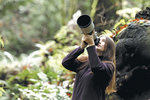
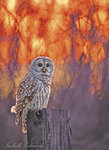
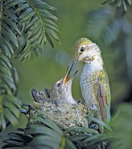
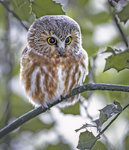
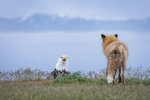

Isabelle (Izzy) Edwards introduced herself to the Key Peninsula community in late September 2021. She posted the first of what would be many spectacular photographs on the Key Peninsula Community and Birding Facebook pages and asked for suggestions of favorite places to view wildlife.
Using social media comes naturally to the 19-year-old photographer and aspiring naturalist and conservationist. She has more than 28,000 Instagram followers on her Northwest Wildlife account and has developed friendships with many fellow professional photographers through those connections.
Her love for nature, she said, was instilled by her parents. She grew up in Maple Valley and remembers going for hikes with them on local trails as soon as she could walk.
Her father suffered a life-altering brain injury just two months before Edwards was born. He was hospitalized for more than a month and the injury prevented him from returning to work. Her parents divorced when she was 10. It was difficult, she said, but she also values the amount of time she was able to spend with her father. While many of her friends saw their fathers just briefly after work and for a few hours a week, she had hours every day.
As her father recovered, when Edwards was about 7, he developed an interest in photography, befriended Art Wolfe, an internationally acclaimed photographer and conservationist, and accompanied him on photography expeditions for a time. When she turned 10, her dad gave her a camera, a Cannon Power Shot. “It was a nice little handy camera that didn’t have any added lenses, and could zoom to 10X,” she said. “That got me interested in taking pictures. I’d take photos in the backyard.”
A few years later her dad gave Edwards some hand-me-down professional equipment and taught her the basics. “I got really hooked with that,” she said. “I would get so excited about taking pictures of the farm animals when we went to visit family in Montana.”
Her dad inspired her to shift her focus from domestic animals to wild ones. “He was the force encouraging me,” she said.
Her mother, though not a photographer, was very supportive. Edwards recalled sitting with her for more than eight hours in the North Cascades until bears appeared. “Wildlife photography is an exercise in patience. There is no instant gratification,” Edwards said.
She fell in love with orcas and at age 13 spent a season as the marine naturalist with Mystic Sea Charters in Anacortes, the youngest person with that position in the state. She began to hone her skills on the boat, photographing and identifying both resident and transient orcas.
Following the whale season, she changed her focus. “I became obsessed with Copic (brand) markers,” Edwards said. “I started a small business drawing portraits of people’s pets or favorite wildlife.” She returned to the camera a year or so later, in 2018. “Drawing really helped my photography,” she said. “Drawing made me look at details more, to think about lighting and all the different elements that go into creating art.”
She began to travel, mostly in the Pacific Northwest, but also to Yellowstone National Park, to Jasper and Banff Canadian National Parks, and the Gulf of Mexico. “I started to realize how precious our Earth really is,” she wrote on the website she created when she was 16.
After receiving her diploma from Tahoma High School in 2021, with college credits through the Running Start program, Edwards treated herself to a trip to Alaska as a graduation present. The photographs she took there, particularly of grizzly bears, count among her favorites. By the time she returned, her father and his second wife had moved to the Key Peninsula. Edwards joined the household and has been getting to know the area since then.
She spends an hour or more four to five times a week in the woods or on nature preserves taking pictures. “About once a month I get a really cool wildlife or nature experience,” she said. Often, she will go to trees where she knows a bird has roosted — owls typically will stay in one place for weeks or a month and hunt at dusk. Sometimes the experience is unexpected; on a recent walk a barred owl swooped by. She followed it, waiting for its third time to perch, when she could take a shot with the sunset shining in the background. “You have to know your subject, stick around, and use restraint in deciding when to take the shot,” she said.
“The most important part of wildlife photography is creating a story with the image,” Edwards said. “How you do that is through composition and lighting. I focus on where I want my subject in the frame and move around to capture the angle that tells the story I want to tell.”
Edwards would ultimately like to work as a naturalist, perhaps a park ranger. “There is an aspect to wildlife photography that is more take than give, with people chasing wildlife around to get that perfect shot,” she said. She’d prefer to be more give than take — to work in conservation and take pictures on the side.
Edwards’ photographs are on Instagram and her website.
Other items that may interest you
UNDERWRITTEN BY THE FUND FOR NONPROFIT NEWS (NEWSMATCH) AT THE MIAMI FOUNDATION, THE ANGEL GUILD, ADVERTISERS, DONORS AND PEOPLE WHO SUPPORT INDEPENDENT, NONPROFIT LOCAL NEWS
